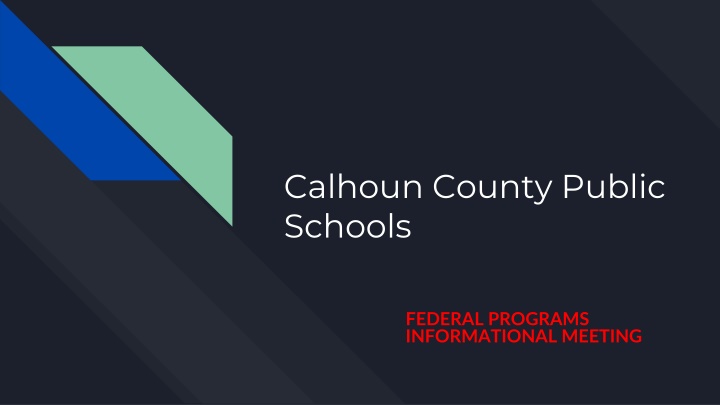
Federal Education Funding Programs Overview
Discover key federal funding programs like ESSA and IDEA supporting low-income students, those with disabilities, and English language learners. Learn about Title I, II, and III funding allocations and their impact on educational institutions.
Uploaded on | 0 Views
Download Presentation

Please find below an Image/Link to download the presentation.
The content on the website is provided AS IS for your information and personal use only. It may not be sold, licensed, or shared on other websites without obtaining consent from the author. If you encounter any issues during the download, it is possible that the publisher has removed the file from their server.
You are allowed to download the files provided on this website for personal or commercial use, subject to the condition that they are used lawfully. All files are the property of their respective owners.
The content on the website is provided AS IS for your information and personal use only. It may not be sold, licensed, or shared on other websites without obtaining consent from the author.
E N D
Presentation Transcript
Calhoun County Public Schools FEDERAL PROGRAMS INFORMATIONAL MEETING
Federal Programs An Overview of Federal Funding Options The main sources of federal education funding programs are the Every Student Succeeds Act (ESSA) and IDEA. ESSA funding supplements state and local resources and supports students from low-income families and low-achieving schools. IDEA is the primary federal funding source for students with disabilities and special education. The main sources of federal funds education vendors should be aware of and familiar with are: Title I, Part A Title II, Part A Title III, Part A Title IV, Part B Title V IDEA, Part B
Title I, Part A The largest federal program aiding elementary and secondary education Goal is to supplement (not supplant) state and local funding to ensure students from low-income families succeed academically Funds are awarded based on formulas that consider the number of low-income students and other factors, such as the cost of education in the state. State Education Agencies (SEAs) award funds to Local Education Agencies (LEAs) based on a similar system. LEAs distribute funds to schools with high percentages of low-income students.
Title II, Part A Aims to improve teacher and principal quality through recruitment and professional development. Funds are awarded based on a formula that accounts for the number of school-aged children in the state and how many are from low-income families. SEAs award funds to LEAs based on a similar formula. To recruit high quality teachers and staff For professional development that increases educators capacity to implement prevention-related services A state makes it a priority to ensure schools are preparing teachers to be well-equipped to lead a classroom. The state allocates Title II, Part A funds for stipends towards training programs that improve teachers classroom management skills, equitable practices, use of data to guide instruction, etc.
Title III, Part A Aims to improve and enhance the education of English language learners (ELLs) and immigrant students by helping them attain English proficiency and meet state academic achievement standards. (Multi-Lingual Learners) ELLs have recently received increased attention due to an ESSA mandate that requires states to provide more detailed information to the public on English proficiency progress and academic achievement for ELLs. State formula grants are provided to SEAs based on the number of ELLs reported through U.S. Census data. LEAs are awarded funds based on the number of ELLs that reside in the district. To increase English language proficiency and student achievement To increase the abilities of staff to improve ELL instruction and assessment Funds can only be used to supplement (not supplant) programs and initiatives that specifically focus on developing English proficiency. A district wants to improve its English Language Development (ELD) program. The district submits a plan to its SEA for funds to purchase technology and software products designed to increase language acquisition.
Title IV, Part B Also called the 21st Century Community Learning Centers program Goal is to provide academic enrichment opportunities to complement regular academic programs. Funds are awarded to SEAs through formula grants based on Title I awards. SEAs must submit applications and involve relevant state agencies (e.g. mental health agency) in their plans. LEAs apply for funds to SEAs through competitive grants. Community-based partners can also apply for funds as long as they coordinate with schools and ensure easy student access to their programs. To provide academic enrichment opportunities to help students (particularly from low- income families in low-performing schools) meet state education standards. A district makes social and emotional learning (SEL) a priority with the goal of increasing academic achievement and creating a safe and supportive learning environment for students. The district applies to its SEA for funding to purchase SEL curriculum and assessments from an education vendor.
Title V Rural and Low-Income School Program The purpose of the Rural and Low-Income School (RLIS) grant program is to provide rural districts with financial assistance for initiatives aimed at improving student achievement. The grant is non-competitive, and eligibility is determined by statute. Awards are issued annually to state education agencies (SEAs), which make sub-grants to local education agencies (LEAs) that meet the applicable requirements. Awards are made to all SEAs that apply and meet the applicable requirements of the act.
